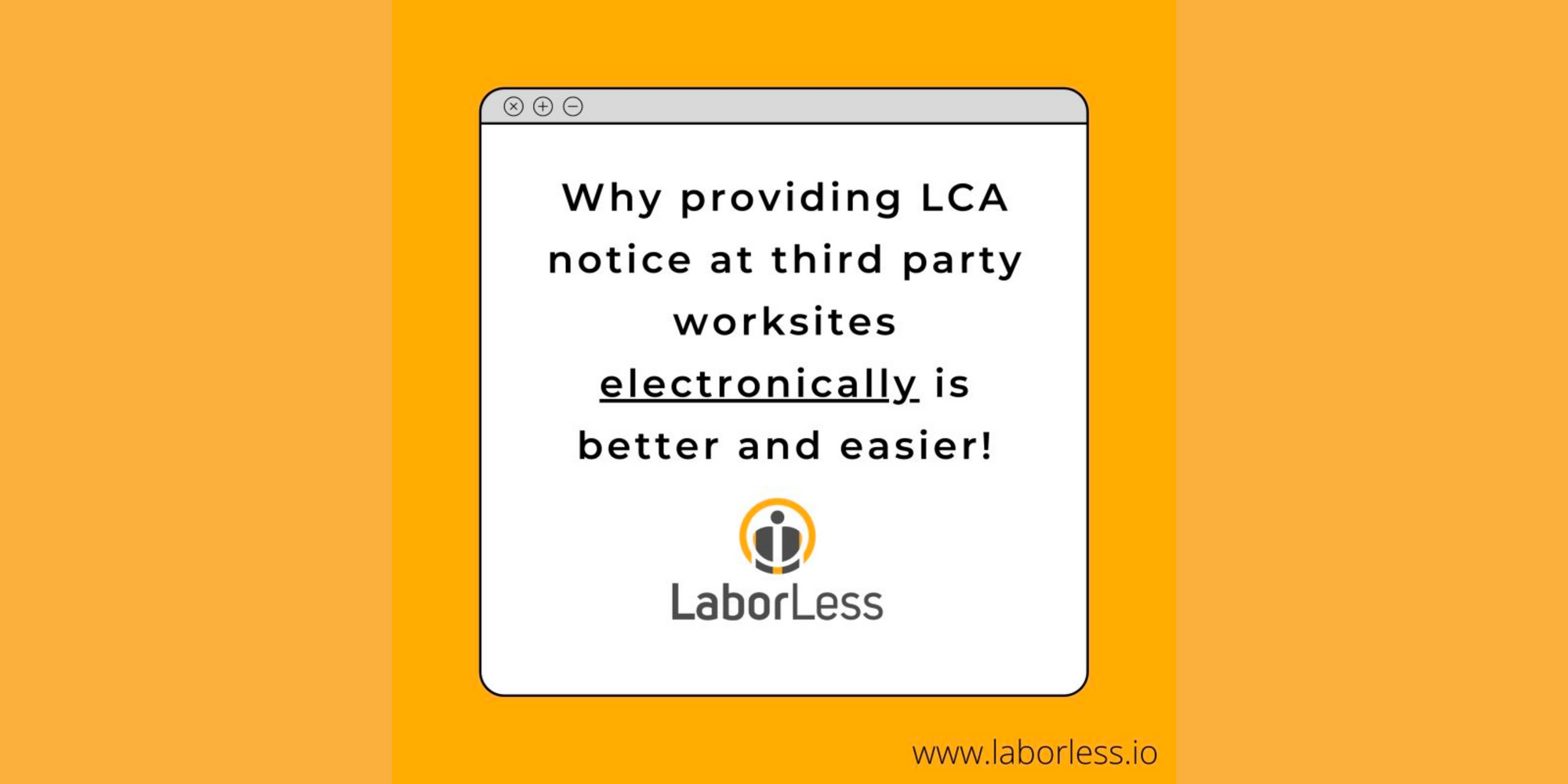Is giving LCA notice at third party worksites a headache?
For most H-1B employers and immigration lawyers the answer seems to be yes. As a best case scenario it’s merely additional back-and-forth between the H-1B petitioning employer, their immigration law firm and the third party worksite where the H-1B worker will be working. Worst case scenario, the third party worksite simply refuses to print and post an LCA notice at their worksite. And then there’s everything in between.
But there is an answer to this dilemma: electronic LCA posting.
So I wanted to share some thoughts on why I think electronic LCA notice is the best way to get around the challenges of LCA notice at third party worksites.
First, some context on third party worksite LCA posting
The context here is simple: when an employer is hiring an employee on an H-1B visa, or is filing an H-1B extension for an existing employee, with the intention of having that employee work at a third party client site, that third party worksite has to include that worksite on the LCA and also provide notice at this worksite (unless it’s a short-term placement - here’s a DOL factsheet and the full regulatory language is here).
For example, when technology consulting or IT staffing firms hire engineers on an H-1B visa and place them at their client sites on short or long-term projects, unless they fall under the short-term placement rule, the hiring company has to both include that worksite on the LCA and make sure that their third-party clients are providing notice to their employees.
Another example might be medical staffing companies that hire nurses, physical therapists or other medical professionals on H-1B visas and place them at nursing homes, hospitals, clinics, etc. Those nursing homes, hospitals and clinics must provide LCA notice to their employees.
This seems fairly straightforward, but quite often these third party worksites don’t want to provide notice to their employees. That’s then the primary H-1B employer, and their immigration attorney, have to make a decision.
What are some ways third party worksites push back against LCA posting requirements?
The main problem is that third party worksites are totally separate companies from the original H-1B petitioner, and so asking them to print and post a piece of paper with salary information from another company (the original H-1B petitioner) is tricky.
Best case scenario, compliant worksites are open to printing / posting LCAs according to the regulations, though not without the added back-and-forth between the main H-1B petitioner, the third-party worksite and the immigration law firm. Often, third party worksites say they comply with LCA posting requirements, but unless someone goes to check, it’s hard to really know.
Worst case scenario, the third party worksite flat out refuses to do so. And while this is anecdotal, we’ve heard from a number of clients that this happens. At this point, the main H-1B employer must determine whether they want to move forward with placing their H-1B worker at this client site. On the one hand, if the H-1B’s business model relies on placing their consultants at third party worksites on projects, they can’t refuse when the third party worksite isn't compliant with LCA posting requirements. On the other hand, they expose themselves to risk in the event of a DOL audit.
And the reasons vary too - some third party clients don’t hire many or perhaps any H-1Bs themselves, and may be sensitive about making that fact known. Others may pay consultants different rates, and even though they may not run afoul of labor laws, the perception of higher or lower salaries for foreign national workers may cause internal unrest at the company.
Whatever the reason, H-1B employers, their third party worksite clients, and immigration lawyers want to remain compliant while making sure third party H-1B placement continues. What’s the best way to balance both sides?
That’s where electronic LCA posting comes in.
Electronic LCA posting is the best solution for third party worksite LCA compliance
Electronic LCA posting enables companies that hire H-1B (and H-1B1 / E-3) workers to comply with DOL’s notice requirements. In 2000, the DOL added 20 CFR § 655.734(a)(1)(ii)(B), finally allowing LCAs to be posted electronically. It states that an employer can electronically post LCAs by means it “ordinarily uses to communicate with its workers about job vacancies or promotion opportunities, including through its ‘home page’ or ‘electronic bulletin board’ to employees who have, as a practical matter, direct access to these resources; or through e-mail or an actively circulated electronic message such as the employer's newsletter.”
In other words, paper LCA printouts, thumbtacks, and coordinating between different work locations isn’t the only way. Here’s why I believe that electronic LCA posting makes the LCA compliance for third party worksites a non-issue.
Electronic LCA posting is less in-your-face.
With electronic LCA posting, instead of printing the LCA notice itself, the third party worksite need only provide notice to the electronic location of the LCA postings. They can print a physical “redirect” notice that has the URL of the electronic bulletin of the LCA notice. They can add the URL to their intranet, or notify their workers in a number of other ways. Whichever method they choose, this gives their workers the information they need without stick LCA papers right in their faces.
It’s less annoying to post LCA notices electronically
Whether using a hard copy redirect notice with the electronic LCA posting bulletin URL, or adding that URL to the third party worksite’s intranet or elsewhere, this information only has to be posted once, after which the main H-1B petitioner can post LCAs electronically without having to bother the third party worksite each time. That’s because with electronic LCA posting, once the notice is uploaded to the bulletin, everyone who has access to it can see it - i.e. it’s posted everywhere.
It’s easier to track electronic LCA posting notices
Third party worksites don’t have to track their LCA postings anymore - it’s hard enough for the main H-1B employer to do as it is. Electronic posting makes it easy to track dates of posting and removal, since it’s all done online, tracked by a system, and has an electronic audit trail.
Honestly, it’s probably more compliant too.
I don’t need to extrapolate on this one. If LCA posting is done and tracked electronically, is thus available at all relevant locations, and can be easily reviewed and audited, it’s easier to stay compliant.
LaborLess is the easiest way to get started with electronic LCA posting
Electronic LCA posting isn’t new - but for years, H-1B employers that have tried to create electronic notification systems on their own have run into problems. That’s why we built LaborLess - to help H-1B employers, and their lawyers, take advantage of electronic LCA compliance.
LaborLess is a cloud-based solution that delivers electronic Labor Condition Application posting and Public Access File management to H-1B, H-1B1 and E-3 employers and the law firms that support them. We've built a proprietary platform that digitizes and streamlines the LCA posting and PAF creation process, eliminating up to 90% of the busy work.
So if you're still coordinating, printing and posting paper LCAs, or even if you're already posting electronic LCAs on your organization's website, LaborLess is for you. Just upload your LCA to your dashboard, enter a few lines of information, review your entry, and click "Post." When you're ready to take it down, another click is all it takes, or set it to come down automatically after a preset number of days.
When an LCA is posted, a PAF is created automatically. Modify its contents, download and share it with attorneys or auditors, or print it out if you need a physical copy for your records.
The best part is, LaborLess collects data along the way, making it easy for you to analyze your LCA and PAF activity with customized reports and insights. Check out our product demo here to learn more.
We’ve made it our mission to bring easy, automated LCA posting to H-1B employers and immigration professionals, so that you can get back to focusing on the complexities of your H-1B cases!

